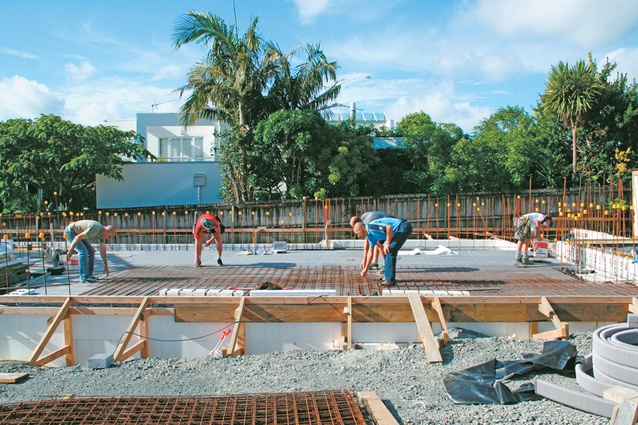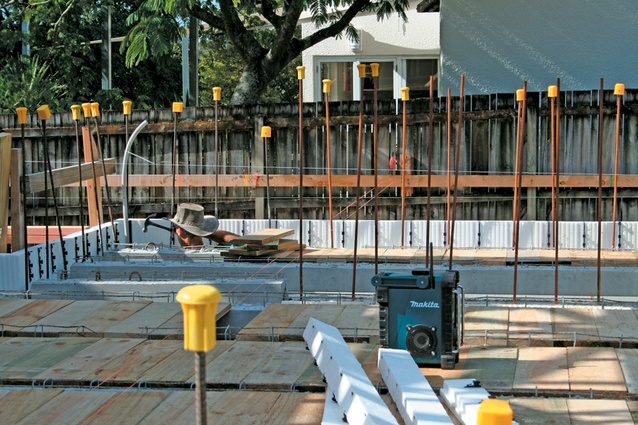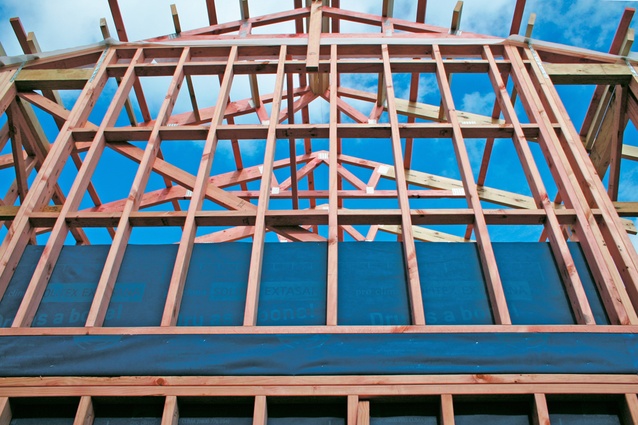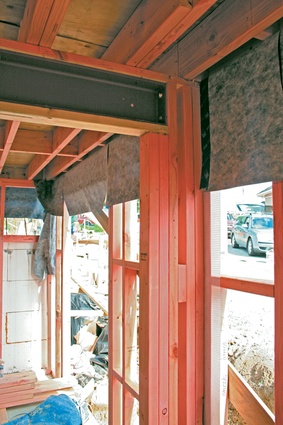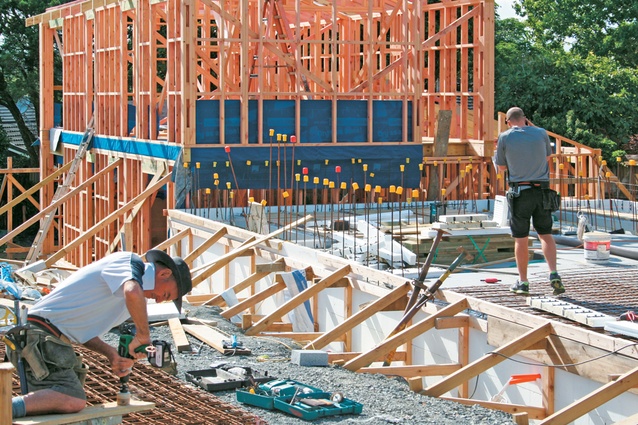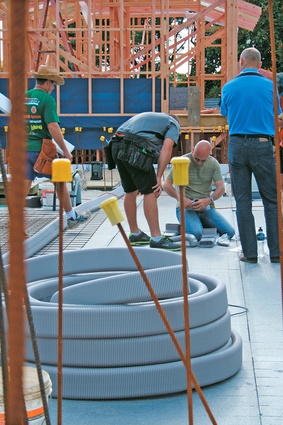Australasia’s first fully certified passive house
After overcoming mountains of red tape and a general lack of expertise and knowledge on passive buildings in this country, Australasia’s first fully certified passive house is finally being built in Auckland. Could this be the start of something good?
Philip Ivanier is a man on a mission. Visiting his house site in Glendowie, Auckland, to meet him and his builder Chris Foley, I was struck by the Canadian’s determination and tenacity in getting this project off the ground. It turns out that building Australasia’s first fully certified passive house wasn’t as easy as Philip and his family first thought.
“We started by designing a house that would be cost effective and functional,” says Philip. “Then we started doing some research into ‘eco’ stuff – mainly because of our kids – and started learning about passive houses … then we discovered that no one had done that in New Zealand [or Australia] before.” Asked why no one had done it here before, Philip was quick to reply: “Because it’s not easy. If you go to the council with a whole bunch of new building techniques you are either adventurous or stupid.”
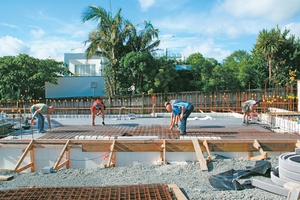
Hurdle number one: planning consent. “There are no front doors in this country that are made to meet the air requirements of a passive house,” says Philip. “You have to blow test the house and if you look at standard Kiwi joinery you can blow through it today. It’s not rocket science – there are lots of pieces that are new but it’s been done 30,000 times in Europe. It’s very sound building.”
Luckily for Philip Auckland Council’s urban design champion, Ludo Campbell-Reid, fully supports Philip’s project and helped get the consent process moving. “Philip phoned up and said ‘look, I’m having real problems getting this through the consent guys, because they don’t know the technology’. A few calls and things are now moving,” says Ludo. “Philip is leading the way here for new forms of environmentally sustainable, high-quality homes that are cheap to run. As a council, we are looking forward to seeing the results and want to empower people like Philip to be able to do things that will improve housing.”
The passive house project is in line with Directive 9.3 in Auckland Council’s Draft Auckland Plan, which says the council should: ‘Encourage and incentivise retrofitting of existing housing stock and require new housing to be sited and designed to address best practice urban design and sustainable housing principles.’
“The guys doing the inspections are happy to come out because they’re seeing something new,” says Philip. Chris Foley, owner of Luxury Living Limited and Philip’s builder, agrees. “Yes, the inspector’s are really keen. And so are other builders. I’ve had a few guys turn up asking to take a look.”
Philip says it’s not just a green project. “Auckland has a huge power issue. If more of these houses were built, power consumption would go down.” In Europe, primary energy use in the built environment accounts for about 40 percent of total EU energy consumption and is the main contributor to GHG emissions – 36 percent of total CO2 emissions. Widespread adoption of the passive house design would have a dramatic effect on energy conservation, with the objective for the built environment to go from an energy consumer to an energy producer.
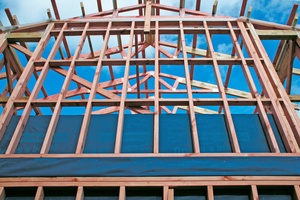
For Philip and his family, it’s also important that this project is seen as a required standard for building, not least from a health perspective. In the Auckland Draft Plan it states: ‘People living in poor quality or substandard houses are more likely to have poor health outcomes and face higher energy costs to keep their houses warm and dry. There is a strong association between asthma and respiratory and contagious illness, and damp, poorly ventilated homes.’
“My wife’s a nurse and it kills us that Housing New Zealand builds pretty base minimal housing and the people who can’t really afford to heat a house suffer and kids get sick, need hospital treatment and so on.
“If Housing New Zealand built to a similar model as this, it would make a big difference,” says Philip. “Housing New Zealand is interested in the passive house project but say ‘we need to prove this in New Zealand’. So the School of Architecture at the University of Auckland is actually going to put some sensors in the house and monitor us.” That’s another reason Philip is doing this. “For me it’s about pushing the technology envelope; it’s in my DNA. I push technology in my day job pretty hard and while we’re taking a punt here, we’re hopeful we can afford the house when it’s all done.”
So, what is a passive house? According to PassivHaus Institut Germany, a passive house is a building in which a comfortable interior climate can be maintained without active heating and cooling systems. The house heats and cools itself, hence ‘passive’. And the standard is not confined to residential; globally, office buildings, schools, kindergartens and a supermarket have also been constructed to the standard. For Philip’s house to become fully certified, however, a rigorous and detailed process must be followed. To assist with this, Philip engaged consultants to oversee the certification process and assist the architects, Jessop Architects, in the design.
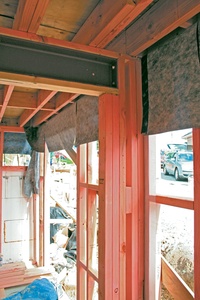
Jon Iliffe is a certified Passive House consultant, and runs EcoBuild Developments. “Philip approached us at the beginning of the project to be responsible for the passive house design and certification,” says Jon. “Our role was to take the preliminary design and load the details into the Passive House Planning Package (PHPP) along with the local climate data. The PHPP software is then able to predict the performance of the building and determine if the house meets the Passive House standard.
“Because the architects had no previous knowledge of this type of energy efficient design, we needed to redesign some of the details to ensure the house would perform correctly and meet the standard. Once the design was modified it was submitted to an independent certifier, a requirement of PassivHaus Institut to maintain the integrity of the standard.”
“This was not originally designed as a passive house; it was designed as a house, and some things changed slightly when we put it through the software,” says Philip. Because this form of building is so new in New Zealand there is no certifier here so EcoBuild chose to use MosArt, a certifier based in Ireland, because of their experience working on projects all around the world. Photographs are being taken of the build as it progresses – as well as all the appliances installed – and sent to MosArt, along with the relevant documentation. “The house has not received its certification yet as it is not complete,” says Jon. “A key factor is the blower door test, which measures air tightness, which although not common here is actually a legal requirement in many countries for new buildings.”
“The test will be to keep this house at 20 degrees Celsius all year round with very little effort and very little cost,” says Philip. “If we can do that, it will be pretty amazing.
“Another thing here is there’s been a lot of thought put into thermal bridging,” says Philip, and points out a steel beam, which sits on vertical braces but doesn’t protrude to the outside wall. “What you have here is basically a radiator which heats the whole house. That’s why it doesn’t go to the outside of the building. And of course the further south you go, the more important thermal bridging becomes.”
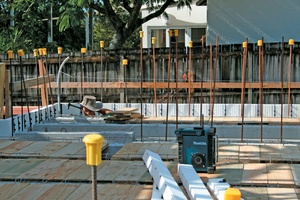
Hurdle number two: materials. “We’re working with Carters and other suppliers to bring stuff in to the country that we need,” says Philip. “Joinery is being assembled here, the ventilation system is on a boat from Europe, and EcoWindows from Raglan are bringing in their profiles from Germany, which are windows that basically open to the inside so they are really well sealed.” Again, proving to the council that the windows met code was challenging, even though all these products have been tested to meet EU standards, which are much more stringent than here.
EcoWindows have now invested in the equipment to build profiles here, and co-owner Bjorn Leswig says because of rigorous government regulations in Germany, manufacturers there are focused on new and better energy efficient windows. There are more than 20 windows and doors being installed on the project. “The windows we’re using in Philip’s house are Visolux and have extremely high R-values and combine energy efficiency with different design options,” says Bjorn. “They are tilt and turn windows. Inwards opening tilt and turn windows are standard in most European countries these days.”
The whole house is wrapped in Pro Clima Solitex Extasana membrane and is fixed directly to the outside of the external wall framing using staples, tape or adhesive. This German technology provides an airtight seal and moisture resistant protection for the house. It doesn’t feel like paper; more like fabric. The timber structures are radiate pine Laserframe and the walls will have additional horizontal internal battens, allowing for both an extra layer of insulation, as well as taking any services, leaving the outside layer unbroken.
Chris explains that the footings and the foundations are insulated using Eco-block which is an insulated concrete form (ICF) made from expanded polystyrene (EPS). Separating the concrete from the ground eliminates thermal bridging. “The Eco-block is also used as the formwork for the concrete strip footings, the concrete floor slab edge and the basement walls,” says Chris. “The reinforced concrete floors are poured over EXPOL 100mm thick EPS polystyrene insulation, which is laid on top of a continuous layer of polythene,” says Chris.
“Beneath the polythene is a layer of compacted sand on top of porous hard fill.” Pipework protrusions are made with sleeves to accommodate the plumbing and wiring and the ducting for the Zehnder ventilation system from Fantech.
“The whole house gets wrapped in an air tight layer and that’s another thing that the council was very concerned about,” says Philip. “The whole house is sealed from the outside and an incredibly efficient ventilation system that again does not exist in this country – it’s coming from Germany – will exchange the air from the outside in.” The unit in question is the Passive House certified Zehnder ComfoAir 350N. Imported by Fantech, the unit is a balanced ventilation system capable of 350m3/hour at 200pa. It has an installed efficiency of 84 percent and uses only 0.29Watts/m3 per hour.
Luc Jorieux, Fantech’s New Zealand manager, says for this project the ducting used has a low profile. “This allows it to be used in-floor to maintain design integrity while ensuring good ventilation across the whole property,” says Luc. “Changeable filters ensure that airborne particles such as pollen and dust are removed, ensuring positive health benefits and improved indoor air quality and comfort.”
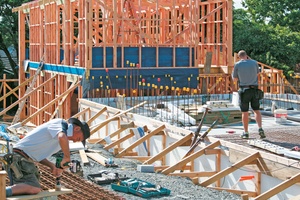
The ventilation system is central to ensuring the house meets the Passive House standard. “It’s proven, it’s tested, it’s certified,” says Philip. “In the end, we can heat and cool the house for $20 a month. “It’s a learning curve for everyone. Sharing knowledge like ‘how do we do this’ or ‘how do we solve that’. I think there’s a good relationship here and without that it wouldn’t work.”
Philip has nothing but praise for his builders. “Chris and his team have done an amazing job in getting the house started and out of the ground. “One of the reasons why this has worked so well thus far is I think everyone’s just working to get it done.”
“Everyone’s forward thinking,” says Chris. “There’s no one being negative about it. Everyone thinks it’s a good idea and a good thing to do.” Philip’s view is that with the knowledge gained on this project, the next passive house built here will be even better. “If we can help push the quality of building in New Zealand forward, then great.”
That pretty much sums up Philip’s altruistic and visionary approach to this project. That and: “Our kids are excited by this. I ride a bike to work, I drive a Prius.”
Certification Criteria
Passive House is a performance standard, not a design standard. A home or building of any architectural style can be Passive House certified. The performance of the design is confirmed using a calculation tool (below), which has been verified against the performance of actual buildings, ensuring that the calculated results are achieved.
A passive house has three key criteria that must be met to achieve certification: Specific space heating and cooling demand is the total amount of energy used each year to keep the building at a safe, healthy and comfortable temperature; [heating load is the maximum amount of heat that can be added at one time]; airtightness test result is the result of a blower door test and total specific primary energy demand is a measure of the energy efficiency of the appliances (heating, cooling, refrigerators etc) in the building.
| 1 Specific space heating and cooling demand | ‹ 15kWh/(m²yr) |
| or Heating load (not site specific) | ‹ 10W/m² |
| 2 Airtightness test result (n50) | ‹ 0.6 air changes/h |
| 3 Total specific primary energy demand | ‹ 120kWh/(m²yr) |
Links
New Zealand’s first passive house blog: passivehouse1nz.blogspot.co.nz
Passivhaus Institut in Darmstadt, Germany: www.passiv.de
Passive House Institute of New Zealand: www.phinz.org.nz
Passive House International: www.passivehouse-international.org
Passive House New Zealand: www.passivehouse.org.nz

